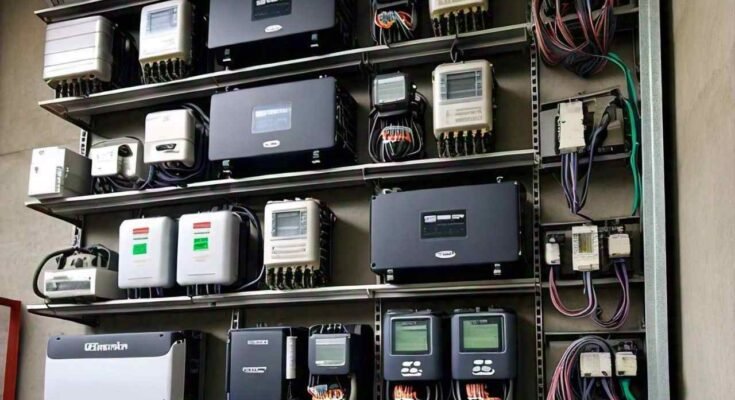A solar inverter is an important component in a solar power system that converts the direct current produced by solar panels into alternating current for use in electrical grid stations and homes. There are different types, such as string inverters, micro-inverters, optimizers, hybrid inverters, and off-gride solar inverters.
Each has unique advantages to ensure the optimum performance of an efficient inverter system. Modern versions offer retort time mitigation and protection; proper installation and maintenance are essential for longevity. Inverters typically last 10 to 15 years, advances in technology have increased their efficiency and durability, making them critical to the efficient use of solar energy.
Solar inverters are available in various sizes for both domestic and industrial use. In this article, we will discuss different types of solar inverters and their performance.
Types of Solar Inverters
The need for solar energy is different in consumption. It varies how the energy is needed, converted, stored, and used. Here are some solar inverters that are used in daily life according to the need for energy consumption.
String Solar Inverter:
A string inverter is a work-type inverter used in residential and commercial solar power systems. It connects a series of solar panels called a string and converts direct current to alternating current for use in businesses.

String inverters are known for their simplicity, cost-effectiveness, and longevity, but they can be less efficient if the panels are shaded or constructed in different ways or different locations. Installed where there is a lack of sunlight, it is popular and preferred because of its ease of installation and lower cost compared to other inverter types such as microinverters.
Hybrid Solar inverter:
A hybrid inverter is a versatile device in a solar power system that can manage power from multiple sources, including solar panels, batteries, and grid electrical systems. Currents stored in batteries are converted into alternating current that is sent to the home for use.
They enable energy storage over time and offer greater energy efficiency and flexibility as they optimize energy use, reduce load on the grid, and simultaneously supply power from solar or batteries.
Modern hybrids often have a smart monitoring feature that allows users to track energy production, consumption, and storage in real time. Can directly monitor energy production and consumption on their mobile devices or computers. The ability to seamlessly manage multiple energy sources is a popular choice for people who maximize the benefits of solar arrays and battery storage systems.
Off-Grid Solar Inverter:
An off-grid solar inverter is an important component in an off-grid solar power system designed to operate independently of a brick-and-mortar grid. Inverters convert direct current to alternating current in locations where on-grid access is not available.
Off-grid solar is typically combined with a battery storage system that provides a good electrical backup in less sunlight. Excess energy is stored in batteries and can be used at night. These often include built-in charge controller systems to manage battery charging and ensure efficient energy use.

These inverters are essential for providing excellent sustainable power in off-grid battery systems. Modern models offer remote monitoring with features such as multiple built-in options and robust protection against loads and short circuits that ensure safety and durability in various environments.
Micro Solar Inverter:
A micro solar inverter is a complex device attached to each solar panel in the photovoltaic system that converts the direct current generated by the panels into alternating current based on the panel. Optimizes the performance of each panel allowing the system to maintain high overall performance even if some panels are in a shaded area.
This design ensures that the performance of one panel does not affect the performance of another panel. Microinverters increase system efficiency and are particularly beneficial for complex solar arrays or different solar installations.
They also offer real-time monitoring systems at the panel level, providing detailed performance data and precise. Although they are generally more expensive than a stack inverter, their ability to maximize energy harvesting and improve system flexibility makes them a popular choice for residential and commercial grid installations.
Conclusion:
Micro, Hybrid, and off-grid solar inverters offer unique advantages to suit specific chancy energy needs. Micro-inverters optimize the tuning of each panel individually in that if one panel’s efficiency decreases, it affects the other panels. Although they are expensive here, but their performance is better than other inverters.
Off-grid inverters convert solar energy into alternating current without a grid, which can be used at home or in places where electrical grid facilities are not available. Ensures direct supply of electricity.
While Hybrid Solar Inverter works on battery, solar, and electricity. Hybrid Solar Inverter combines energy with batteries and completes its production from electricity when needed Hybrid Solar Inverter during night hours starts drawing electricity from the grid when the gain-off-grid system uses batteries to supplement electricity production at night and stores the current in the battery.
Learn more about:
Which solar inverter should be used for domestic purposes?
It depends on your usage and available facilities. it is recommended to use an off-grid solar inverter if the supply of grid electricity is limited or not available, but if you want to add grid electricity then should use a hybrid inverter.




One Comment on “Types of Solar Inverter-2025”